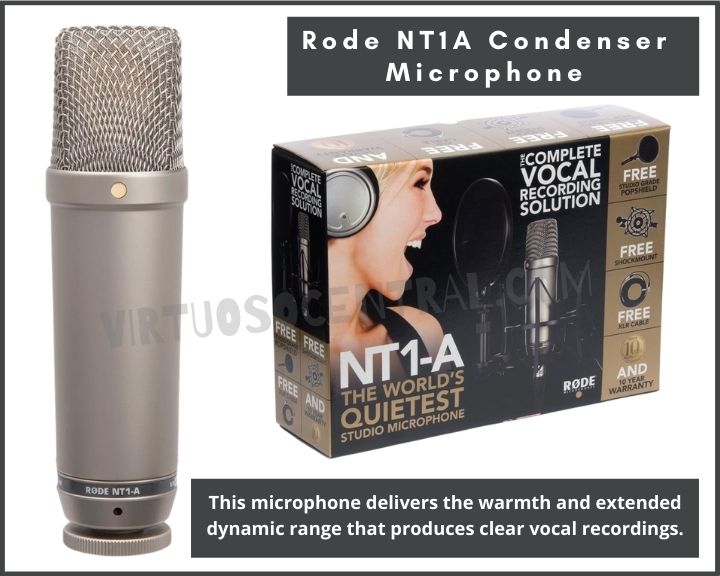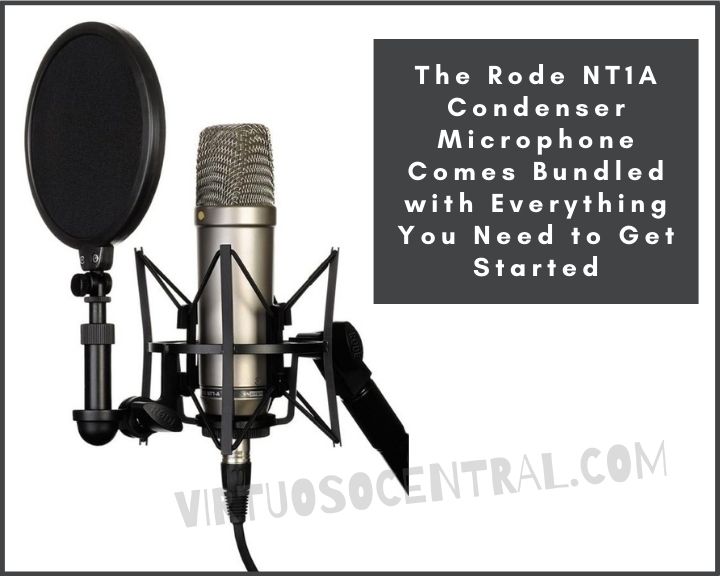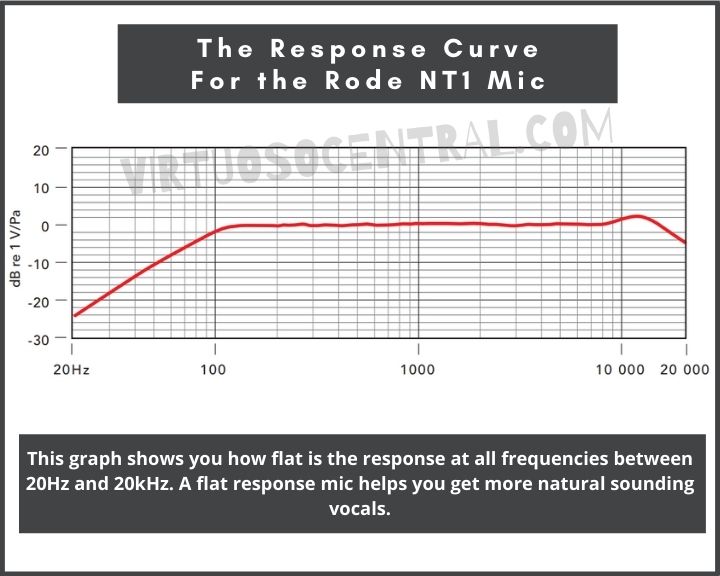Microphones are one of the most important elements in your home recording studio and sometimes it can be very difficult to pick out the right microphone for your recording needs, especially if you are recording Rap vocals.
Rode produces many different types of microphones and each one is tailored for a specific sonic characteristic.
So, which one is the best Rode microphone for rap vocals? The short answer is the Rode NT1A.
In this article, I will be showing you the reasons why the Rode NT1A condenser microphone is the best Rode mic for recording rap vocals. We also take a look at some of the features and specifications that need to be considered when selecting a microphone for recording rap vocals.
Overview
The beauty of this microphone is that it reproduces what you put in front of it, delivering the warmth and extended dynamic range that produces clear vocal recordings.
There are many condenser microphones out there that are of good quality but the Rode NT1A was designed to be used as a microphone for vocal recordings.
Another thing to keep in mind is that Rode produces all its microphones and components in-house, meaning that there is an unmatched quality control from design to manufacturing.
The NT1A and all Rode microphones and designed and manufactured in Australia.
Another plus about choosing this microphone other than for its great sonic quality is that Rode offers a 1-year warranty with a free extension to 10 years by registering the product on their website.
This is a product that you can buy with confidence because the manufacturer is so sure about its quality that is backed up with an extended 10-year warranty.

What’s in the Package
The NT1-A is a complete vocal recording solution. The package includes the NT1-A mic, a studio-grade pop filter with shock mount, a premium 20-feet microphone cable, dust cover, and an instructional DVD packed with recording tips.
Pros of the NT1A:
- Large 1” capsule with a gold-plated diaphragm.
- Cardioid polar pattern.
- Very low self-noise of only 5dB.
- Wide dynamic range.
- Ultra-low noise, transformerless surface mount circuitry.
- Internal capsule shock mounting.
- 10-year extended warranty when you register your microphone on Rode’s website.
- Comes bundled with accessories.
Cons of the NT1A:
- Some users have complained that it is sibilant making a hissing sound on the high frequencies.
- Could be heavy on the lower frequencies

Features to Consider when Selecting a Microphone for Recording Rap Vocals.
There are a few specifications that you should keep in mind when selecting a microphone for vocal recordings. The capsule size or diaphragm, polar pattern, frequency response, and maximum Sound Pressure Level or SPL.
Capsule Size or Diaphragm
There are small and large-diaphragm sizes. When choosing a condenser microphone for recording vocals, make sure you chose one with a large diaphragm.
A diaphragm is considered large if its capsule is 1 inch in diameter. A small microphone diaphragm is a ½ inch in diameter.
Medium diaphragm microphones have a capsule that is between 5/8 to 3/4 of an inch in diameter such as the Rode NT3 and AKG C100.
Large vs Small Diaphragm Microphones
Small diaphragm mics are preferred by producers and sound engineers to record instruments such as piano, violins, acoustic guitars, string ensembles, and choirs.
The reason for this is that they have lower sensitivity, higher sound pressure levels, and a higher dynamic range.
Large-diaphragm microphones are great if you want a big and warm sound. They have high sensitivity, lower sound pressure level capability, and a lower dynamic range. Making a large diaphragm the best choice for recording rap vocals.
Home producers and professional studios prefer large capsules for vocal recordings because it adds richness to the sound and accentuates the low frequencies giving you a professional record quality.
The Rode NT1A has a large diaphragm that it’s 1” in diameter. This microphone delivers a warmer sound around the low frequencies making it a perfect choice that delivers professional rap vocal recordings at an affordable price.
Polar Pattern
There are different microphone polar patterns, these are omnidirectional, sub-cardioid, cardioid, super-cardioid, hyper-cardioid, bi-directional, and shotgun.
The most common is cardioid. Most vocal microphones have this type of pattern. Also known as the heart-shaped pattern, cardioid basically picks up what is in front of it, reducing its sensitivity on the sides and in the back.
When using microphones that are very sensitive such as large-diaphragm capsules, it is ideal to use a cardioid polar pattern, because this reduces noise in recordings.
The Rode NT1A is a cardioid microphone, making it one of the best mics for recording rap vocals. You can check the current price on Amazon.
Frequency Response
When selecting a microphone, it is important to make sure that it can pick up a wide range of frequencies.
Most condenser mics have a frequency response that goes from 20Hz to 20kHz.
A healthy young person can hear from 15Hz up to 18kHz. So, whatever the microphone picks while recording it is going to be within the human hearing range or in some cases exceed our hearing capability.
The NT1A has a frequency range from 20Hz – 20kHz providing a wide range for picking up clear vocal recordings.

Maximum Sound Pressure Level or SPL.
A typical specification for microphones is the max SPL. This indicates the highest sound pressure level a mic can handle before distorting the sound.
In simpler words, it’s a measure of the highest volume the mic can support before sounding distorted.
This is measured in decibels, the higher the number the more SPL the mic can handle.
The max SPL for the Rode NT1A is 137dB. This is around what most modern condenser microphones can handle.
Any rapper can be confident that if recording with this microphone and using the correct preamp and audio interface, your home studio recordings will be of professional quality.
Connection and Power Requirements
All condenser microphones require 48 volts to function, this is called Phantom Power. Most modern audio mixers, preamps, and interfaces include the 48 volts supply for condenser mics.
Most condenser microphones connect to the audio mixer, preamp, or interface using an XLR connection. This cable feeds the voltage to the mic and brings the captured signal to the board.
Some condenser mics use a USB port to connect to a computer. This USB cable feeds the needed voltage to make the microphone work and brings the digital signal back to the computer to be recorded.
If you are planning to create a high-quality recording, it’s not recommended to use a USB microphone.
It is much better to use a good quality microphone with a preamp and an interface to create studio-quality sound at an affordable price.
To learn more about mic preamps for vocals and know which one would be the best for your rap recordings, make sure to check this article.
Conclusion
If you are in the market for the best rode mic for rap vocals, make no mistake and choose the Rode NT1-A. It has become an industry-standard providing warm sound, extended dynamic range, clarity, and high SPL capability usually only featured by some of the most expensive microphones but at a fraction of the price.
This microphone has been in the market for several years and anyone who has used it in the studio can agree that it is a good microphone for vocals, especially in high SPL cases such as when recording rap vocals.